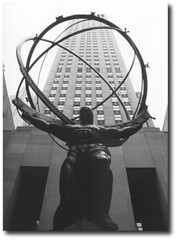The real cost of global warming
Ok, let’s assume Al Gore and the global warming people are 100% correct. That is, man is messing up the planet and the only way to avoid the rise in temperature is to cut off significantly carbon emissions.
What does that really means? Wearing a sweater? Riding a bike to work?
Not quite.
According to David Morris, a co-founder and vice president of the Institute for Local Self Reliance in Minneapolis, Minnesota and director of its New Rules project, here is the real price the world would have to pay:
“The implications of biospheric equity are so profound and so disturbing, that it is understandable why American environmentalists shy away from discussing the issue. Currently, global carbon emissions are about 7 billion tons, roughly, 1 ton per person. But the average American generates, directly and indirectly, some 10 tons per capita. Thus, to save the planet and cleanse our resource sins, Americans must go far beyond freezing greenhouse gas emissions. As a nation, we must reduce them by more than 90 percent, taking into account the sharp reductions in existing global emissions necessary to stabilize the world's climate.
Suddenly we realize that addressing the global warming problem will be very difficult, not only politically but economically and institutionally. And it may well entail significant sacrifice.
…
Although none of the reductions will be easily achieved, Monbiot's analysis concludes that those related to transportation may be the hardest of all. To reduce ground transportation emissions sufficiently, he suggests the need to severely lessen individual shopping trips. To accomplish this, he proposes that goods be delivered. He cites a UK Department of Transportation study that notes, "a number of modeling exercises and other surveys suggest that the substitution of private cars by delivery vehicles could reduce traffic by 70 percent or more." Every van the stores dispatch, in other words, takes three cars off the road. Monbiot also proposes to transform out of town superstores into warehouses, to be visited only by vehicles that pick up supplies. That will save even more energy, because warehouses use only 35 percent as much heat and 29 percent as much electricity as do stores.
…
In only one sector does Monbiot fail to identify a technical solution at any cost: air travel. Flying generates about the same volume of greenhouse gases per passenger mile as a car. But, of course, flights are many miles longer than drives. Fly from New York to California and back and you will generate as much greenhouse gas emissions as you will by driving your Prius all year.
Monbiot reluctantly concludes, "(T)here is simply no way of tackling this issue other than reducing the number, length and speed of the journeys we make." Knowing the audience for whom the book is intended, he acerbically adds, this will mean the end of "shopping trips to New York, political meetings in Porto Alegre, long distance vacations."He urges his readers "to remember that these privations affect a tiny proportion of the world's people. The reason they seem so harsh is that this tiny proportion almost certainly includes you."
Ok, so no more driving to a supermarket, no more traveling by plane, and so on.
Can you just imagine the consequence of these measures in the real world? I mean, to implement this would make the crash of 29 look like pocket change.
That is why nobody talks about the price.
And of course the most affected would be “the rich”. But let’s not forget that it is “the rich” who produces the large majority of goods, including machinery, medicine, communication, etc. If push comes to shove, I have no doubt that the poor countries would be affected economically in catastrophic ways.
There is no way, politically or economically that this can be done. Period. We have to find another way.
